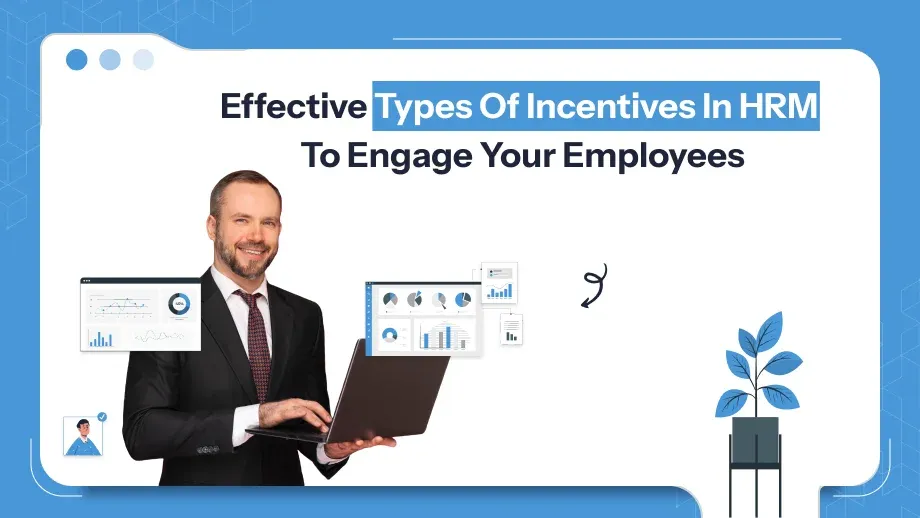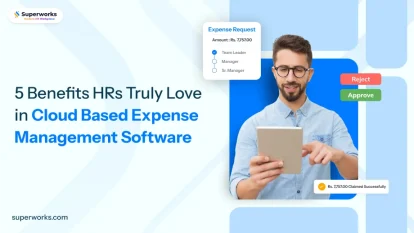
Organizational success must rely on employee engagement. Motivation and job satisfaction by an effective workforce mean increasing productivity and reducing turnover. Well-designed incentives, a valuable tool in Human Resource Management, provide engagement at types of incentives in HRM financial, professional, and personal needs and help bring out the feeling of value and recognition.
What Are Incentives in HRM?
Incentives in HRM are the rewards to the employees given in the form of benefits to recognize their performance and encourage certain behaviors or outcomes. The types of incentives in HRM can be monetary or non-monetary, and there is a prime focus on improving motivation, satisfaction, and loyalty.
Types of Incentives & How You Can Implement Them?
Incentives work well in helping organizations increase engagement, productivity, and satisfaction by employees. Incentives help develop an inspired and devoted workforce once various types of incentives in HRM are known and applied in the right context. Incentives address a range of different employee needs for financial security, career development, and other personal and organizational objectives.
Financial Incentives
Financial incentives are those rewards directly associated with an employee’s pay. These are the most common types of incentives in HRM, pushing employees to accomplish certain performance targets.
- Bonuses: Cash bonuses in case of exceeding or meeting a performance target.
- Profit Sharing: Employees receive a portion of the company’s profits.
- Incentive Wage Plans: Wages over and above the normal pay based on productivity or efficiency.
Non-Financial Incentives
Non-monetary incentives are recognition of employees and acknowledgment of them without any monetary benefits, to improve morale and job satisfaction.
- Recognition Programs: Awards like “Employee of the Month” or public acknowledgment.
- Work-Life Balance Benefits: Flexible working hours, remote options, and wellness programs.
- Personalized Rewards: Hobby-based gifts or special privileges.
Career Development Incentives
Non-monetary rewards are incentives to employees that do not involve monetary gains but are designed to enhance the morale and job satisfaction of employees.
- Training Programs: Access to certifications, workshops, and online courses.
- Promotion Opportunities: Advancing to leadership roles based on merit.
- Mentorship Programs: Pairing employees with experienced mentors for professional guidance.
Team-Based Incentives
Encouraging collaboration through group rewards fosters teamwork and camaraderie.
- Shared Bonuses: Teams receive collective rewards for achieving goals.
- Team Outings: Celebrations like team lunches or retreats.
- Recognition Events: Celebrating project milestones with awards.
Long-Term Incentives
Long-term incentives focus on loyalty and retention of top talent.
- Stock Options: Share options in the company at a discounted price.
- Retirement Benefits: Matching contributions for pension schemes or gratuity plans.
- Loyalty Bonuses: Incentives to employees who continue with the organization for a particular period.
Boost employee performance with the best types of incentives in HRM.
Find out how to implement them effectively!
How to Implement Incentives?
Understand Employee Preferences
Survey your employees to identify what motivates them. Financial rewards might appeal to some, while others value career development opportunities or recognition.
Align Incentives with Business Goals
Design incentive plans that motivate behaviors and outcomes that are in line with the organization’s objectives. For instance, use types of incentive plans like team-based bonuses to encourage collaboration.
Customize Incentive Plans
Tailor incentives to meet the diverse needs of your workforce. For example, junior employees may prefer learning opportunities, while senior employees might value profit-sharing plans.
Use Technology for Management
Leverage HR technology to streamline the administration of incentives. Tools like cloud-based HRMS solutions simplify the tracking and disbursement of rewards.
Communicate Clearly
Transparency is key. Communicate the criteria for earning incentives and ensure that all employees understand the reward structure.
Evaluate and Adjust Plans
Review your incentive plans periodically. Use feedback and performance data to refine your strategies and keep them relevant.
Importance of Incentives in HRM
types of incentives in HRM as they have a direct influence on the success of an organization through a motivated and satisfied workforce.
Boosts Productivity
Incentives make employees work harder and accomplish their goals. Aligning individual goals with organizational objectives increases productivity levels significantly.
Improves Job Satisfaction
When employees feel appreciated for their efforts, they are likely to remain loyal to the organization. Non-financial rewards, such as recognition, contribute heavily to job satisfaction.
Attracts and Retains Talent
A well-designed incentive plan for employees helps attract top talent and reduces turnover rates. Competitive rewards make the organization appealing to skilled professionals.
Enhances Workplace Morale
The incentives create a positive work environment where the employee feels valued, which then increases morale and improves teamwork.
What Are Common Incentive Mistakes?
Here’s a quick overview of common incentive mistakes and how to avoid them so that your types of incentives in HRM can be impactful and effective. Leverage tools like cloud-based HRMS software that would help address all these challenges pretty seamlessly.
Focusing Solely on Financial Incentives
Using only monetary rewards ignores other incentives, such as recognition and career development opportunities, which might be missed. Financial rewards alone are too narrow and may not appeal to every employee.
Solution: Combine monetary incentives with non-monetary ones to address the variety of motivations within the employees. For instance, linking incentive management to a payroll and HRMS system ensures both financial and non-monetary rewards are tracked and managed effectively.
Ignoring Employee Preferences
The one-size-fits-all incentive plans do not strike a chord of the hearts of different employees. Single-type incentives like financial bonuses may offend employees who seek growth opportunities and flexibility.
Solution: Use surveys or discussions to tailor incentive plans to individual preferences. Tools like cloud-based HRMS software allow for personalized incentive tracking, making it easier to cater to varied employee needs.
Setting Unrealistic Goals
Incentives tied to unattainable goals demotivate employees and cause frustration. Overly ambitious targets might discourage employees rather than inspire them to perform better.
Solution: Formulate goals that are challenging but achievable to stimulate performance. A cloud based HRMS software platform will assist managers in framing goals that are challenging yet realistic and align the same with organizational capabilities by analyzing past performance data.
Failing to Align Incentives with Business Goals
Misaligned incentives reward behaviors that do not contribute to organizational success. For instance, focusing on individual performance in a team-driven project may lead to conflicts and reduced collaboration.
Solution: Tie incentives directly to company objectives and desired outcomes. By integrating incentives into a payroll and HRMS system, organizations can ensure rewards align with strategic goals, improving overall efficiency.
Overcomplicating Incentive Programs
Complex rules and structures discourage employee participation and lead to misunderstandings.
Solution: Keep incentive programs simple and user-friendly, leveraging HR technology for management.
How to Design Effective Incentive Plans in HRM?
In designing an effective incentive plan types of incentives in HRM, the planner in question must consider employee needs and organizational goals. This is what to do in approaching a workable plan:
Understand Your Workforce
Before devising the incentive scheme, understand what motivates an employee. While for some people, the carrot of money is the right stimulus, for others, the possibility of promotion is better.
Align Incentives with Business Goals
Incentives must motivate behaviors that help attain organizational goals. For example, team-based incentives may be a way to build teamwork on larger projects.
Promote Fairness and Transparency
Employees should believe that the incentive program is just and unbiased. Communicate the criteria for earning rewards and ensure everybody has an equal opportunity to participate.
Customize Incentive Plans
Not all employees share the same tastes. Tailor incentive plans for the diverse needs of your workforce, such as offering both financial and non-financial rewards.
Use Technology to Streamline the Process
HRMS tools simplify incentive management by automating calculations and tracking performance metrics. Cloud-based solutions like HRMS cloud enable real-time monitoring of employee achievements.
Regularly Evaluate and Update Plans
Employee needs and organizational goals constantly change. Incentive plans should be periodically reviewed to determine effectiveness and the need for modification based on feedback and performance measures.
How Do Incentives Affect Employee Performance?
Incentives play a great role in determining worker performance management, job satisfaction, and general work engagement. Organizations encourage workers to perform above their duties by offering tangible rewards for accomplishing specific goals or exhibiting specified behaviors. A well-designed incentive strategy aligns employee efforts with organizational objectives, creating a win-win situation between the employees and the organization. It boosts motivation and productivity.
Boosts Motivation and Productivity
One of the most direct impacts of types of incentives in HRM is an increase in employee motivation. Incentives motivate employees to work better by rewarding their efforts, thereby increasing productivity. For instance, financial rewards such as an incentive wage plan motivate employees to achieve or exceed performance targets, thereby fostering a culture of excellence.
Encourages Goal-Oriented Behavior
Incentives make the employee performance goals align with the organizational objectives. The more the employees know that their efforts directly relate to specific rewards, the higher the probability that they will always concentrate on achieving those particular goals. For instance, the introduction of incentive plans in HRM that reward high performance encourages employees to focus on tasks leading to the company’s success.
Enhances Employee Satisfaction and Retention
When workers are satisfied with their jobs, they tend to stay in that organization for an extended period. A good work environment is created as the organization takes note of contributions from employees by recognizing and rewarding them. More than financial incentives, non-monetary incentives including recognition programs, professional development opportunities, and health benefits boost employees’ morale, hence the use of incentives within HR systems.
Builds Healthy Competition
Offering team-based incentives or individual rewards for achieving milestones creates a sense of healthy competition among employees. This competition drives innovation, efficiency, and teamwork. For example, types of incentives in HRM like team bonuses encourage collaboration while pushing employees to perform at their best.
Conclusion
Well-designed types of incentives in HRM can change employee engagement, productivity, and retention. With financial and non-financial incentives, businesses can shape a positive and motivated work environment. With cloud-based HR software, tools for incentive management are further made easier for easy integration with HR operations. Now, start building effective types of incentives in HRM to drive your workforce toward greater success!





